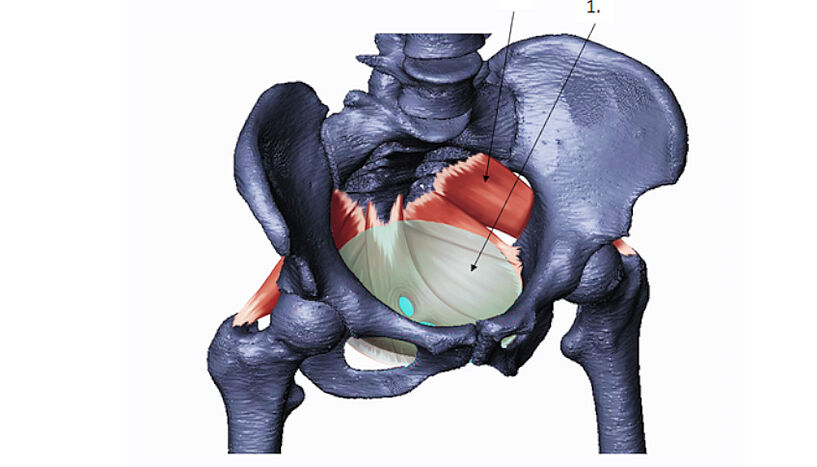Childbirth versus pelvic floor stability: An evolutionary history of compromises
13. April 2021
A human pelvis and muscles of the pelvic floor, which span the bony pelvic canal. The model (1, transparent cyan) used in the analysis is shown superimposed on the pelvic floor muscles (2, red). (© Katya Stansfield)
Human childbirth is comparatively difficult because our babies’ heads are large relative to our birth canals. This tight "fetopelvic" fit increases the risk of obstructed labor, which in turn has potentially dire outcomes for both mother and child. It has long been thought that bipedalism prevents further widening of the human pelvis. Evolutionary anthropologists from the University of Vienna and colleagues now present evidence for a different explanation, published in PNAS. A larger bony pelvic canal is disadvantageous for the pelvic floor’s ability to support the fetus and the inner organs and predisposes to incontinence.
The human pelvis is simultaneously subject to obstetric selection, favoring a more spacious birth canal, and an opposing selective force that favors a smaller pelvic canal. Previous work of scientists from the University of Vienna has already led to a relatively good understanding of this evolutionary "trade-off" and how it results in the high rates of obstructed labor in modern humans. However, it has remained unclear what the advantage of a narrow birth canal is, given its disadvantage for childbirth. It has long been thought that a smaller birth canal is advantageous for bipedal locomotor performance. A different, less prominent explanation is that it enhances pelvic floor functionality. The muscles of the human pelvic floor play a vital role in supporting our inner organs and a heavy fetus, and in maintaining continence. A larger pelvic canal would increase the downward deformation of the pelvic floor, increasing the risk of pelvic floor disorders, such as pelvic organ prolapse and incontinence. However, this "pelvic floor hypothesis" has been challenging to prove.
A team of evolutionary anthropologists and engineers from the University of Vienna, the Konrad Lorenz Institute for Evolution and Cognition Research, and the University of Texas at Austin (USA) used a new approach to test this hypothesis. The researchers, led by Katya Stansfield and Nicole Grunstra from the Department of Evolutionary Biology, simulated a Finite Element model of a human pelvic floor across a range of different surface areas and thicknesses and investigated the deformation in response to pressure. "Finite Element analysis allowed us to isolate the effect of pelvic floor geometry by controlling for other risk factors, such as age, number of births, and tissue weakness," says Stansfield. This approach also enabled the team to model pelvic floor size across a broader range of variation than can be observed in the human population, "because natural selection may prevent the occurrence of such 'extreme' sizes precisely because of the disadvantages for pelvic floor functionality,” explains Grunstra.
As predicted by the pelvic floor hypothesis, larger pelvic floors deformed disproportionately more than smaller pelvic floors. "Our results support the notion that smaller pelvic floors – and thus smaller birth canals – are biomechanically advantageous for organ and fetal support despite their disadvantage for childbirth," says Stansfield.
The researchers also found that thicker pelvic floors were more resistant to bending and stretching, which partly compensated for the increase in pelvic floor deformation as a result of increased surface area. So why did natural selection not result in a larger birth canal that eases childbirth, along with a disproportionately thicker pelvic floor that compensates for the extra deformation? "We found that thicker pelvic floors require quite a bit higher intra-abdominal pressures in order to undergo stretching, which is actually necessary during childbirth," says Grunstra. The pressures generated by women in labor are among the highest recorded intra-abdominal pressures and they may be difficult to increase further. "Being unable to push the baby through a resistant pelvic floor would equally complicate childbirth, and so we think we have identified a second evolutionary trade-off, this time in the thickness of the pelvic floor," concludes Grunstra. "Both the size of the birth canal and the thickness of the pelvic floor appear to be evolutionary ‘compromises’ enforced by multiple opposing selective pressures," says co-author Philipp Mitteroecker.
Full citation of the paper:
Stansfield E, Kumar K, Mitteroecker P, & Grunstra NDS. Biomechanical trade-offs in the pelvic floor constrain the evolution of the human birth canal. PNAS, doi.org/10.1073/pnas.2022159118.
Wissenschaftlicher Kontakt
Dr. Katya Stansfield
Department für Evolutionsbiologie, Unit für Theoretische BiologieUniversität Wien
1090 - Wien, Althanstraße 14
katya.stansfield@univie.ac.at
Rückfragehinweis
Pia Gärtner, MA
Pressebüro der Universität WienUniversität Wien
1010 - Wien, Universitätsring 1
+43-1-4277-17541
pia.gaertner@univie.ac.at
Downloads:
becken_01.jpg
Dateigröße: 203,07 KB
